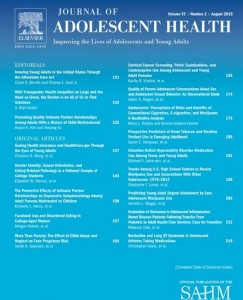 A new article published in the August issue of The Journal of Adolescent Health, the official journal of the Society for Adolescent Health and Medicine finds the prevalence of eating disorders in transgender college students is far greater than any cisgender man or woman. Cisgender refers to people who identify their personal identity with the gender they were assigned at birth.
A new article published in the August issue of The Journal of Adolescent Health, the official journal of the Society for Adolescent Health and Medicine finds the prevalence of eating disorders in transgender college students is far greater than any cisgender man or woman. Cisgender refers to people who identify their personal identity with the gender they were assigned at birth.
The study, carried out by members of Washington University at St. Louis, accessed data from 289,024 students from 223 U.S. universities participating in the American College Health Association-National College Health Assessment II, a national survey of a broad range of health behaviors, outcomes and perceptions among college students. To identify eating disorders, students were asked if they have been diagnosed or treated by a professional for anorexia or bulimia in the past year. Cisgender students also identified as heterosexual, unsure or sexual minority.
Transgender students responded that they had been diagnosed with an eating disorder in the past year at an alarming rate of 15.82%. Cisgender students were between .55% (heterosexual men) and 3.66% (unsure men). Cisgender sexual minority and unsure men and women were 2-4 times more likely to have been diagnosed with an eating disorder than heterosexual men and women.
The study also measured past-month diet pill use. Transgender students (13.5%) also reported much higher usage rates than heterosexual men (1.88%) and heterosexual women (4.29%).
The authors, led by Dr. Alexis E. Duncan, offer a couple potential explanations for the findings.
“Transgender individuals may use disordered eating behaviors to suppress or accentuate particular gendered features. It has been suggested that striving for weight loss may be a way for transgender women to conform to feminine ideals of slimness and attractiveness,” the authors state.
Another reason, the authors point out, is a common trigger of eating disorders is stress, and there is research to suggest the stress levels in these individuals is elevated as a result of belonging to a stigmatized social category.
“Among lesbian, gay, and bisexual individuals, a strong link has been found between higher levels of minority stress and poorer mental health outcomes. The same mechanisms are likely at play in transgender individuals, who may be exposed to substantial amounts of discrimination, both on an interpersonal and societal level,” the authors assert.
To read the full article, please visit jahonline.org/ or http://www.jahonline.org/article/S1054-139X%2815%2900087-7/abstract
To learn more about SAHM, go to www.adolescenthealth.org.












I can imagine that a transgender has more difficulty in sorting out their likes and dislikes in addition to resolve their gender. Parents, at least of my generation and before, did not know that their children would be born with gender differences so they brought their children up as what their physical appearance was. I am gay and I had to figure that out as my sexual desire is for the same gender. Fortunately, I was OK with the gender I was born with as a male.
There’s no such thing as “a transgender.” There are, however, transgender women, transgender men, and transgender people.